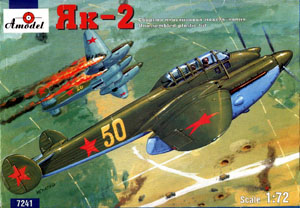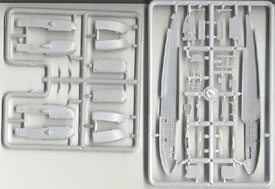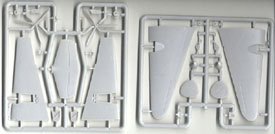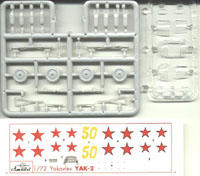| |
|||||
Amodel 1/72 Yakovlev Yak-2By Matt Bittner |

|
During the fall of 1938 the Design Group of Aleksandr Yakovlev contemplated a small, twin-engined machine characterized by unprecedented performance. The resulting design No.22 was a classic Yakovlev OKB creation, being very light in both construction and provision, and was remarkably clean and streamlined.
When the prototype commenced testing as the BB-22 (blizhny bombardirovchik-- short-range bomber) during the spring of 1939, the decision had been made to develop the machine as a high-speed bomber (thus the designation). The aircraft featured a single-piece central fuselage and wing structure made of wood, and with highly polished 'shpon' laminate skinning. The forward fuselage was covered in dural sheet, while the rear fuselage was of classic steel tube construction and fabric covered. Two 960 hp M-103 engines powered the BB-22
The BB-22 prototype's very high performance (it reached 352 mph, with the prospect of higher speeds) masked a considerable number of other difficulties, ranging from inadequate engine cooling to poor stability. Indeed, the continual upward spiral of the machine's weight by various military equipment and stores only exacerbated matters.
 Great hopes had been placed in the BB-22, and plans were put in motion for production
at no fewer than four factories. The attack machine, finally named Yak-2 to
accommodate the newer naming convention, failed by some margin to live up to
any of the expectations accorded to it, and in the end only Factories 1 and
81 produced any examples of the type, while production was rapidly abandoned.
Development of the BB-22 did continue with several proposals powered by the
M-105, however, and limited production of the Yak-4 reconnaissance version with
these motors did ensue. Total deliveries of the Yak-2 and -4 are thought to
be 201 aircraft, and 97 machines of these types did see action in the opening
phases of Barbarossa. Remarkably, one Regiment (118 ORAP) managed to operate
their Yak-4s right through to 1945.
Great hopes had been placed in the BB-22, and plans were put in motion for production
at no fewer than four factories. The attack machine, finally named Yak-2 to
accommodate the newer naming convention, failed by some margin to live up to
any of the expectations accorded to it, and in the end only Factories 1 and
81 produced any examples of the type, while production was rapidly abandoned.
Development of the BB-22 did continue with several proposals powered by the
M-105, however, and limited production of the Yak-4 reconnaissance version with
these motors did ensue. Total deliveries of the Yak-2 and -4 are thought to
be 201 aircraft, and 97 machines of these types did see action in the opening
phases of Barbarossa. Remarkably, one Regiment (118 ORAP) managed to operate
their Yak-4s right through to 1945.
The A-Model Yak-2 consists of 92 gray, injected molded parts with another 10 injected clear. There are decals for two schemes, both Army Green 4B0 over AII Blue. The first scheme is for a Yak-2 of the 316 PAR, Southwest front, July-August 1941, crewed by I. M. Agarkov as commander. The second scheme is a machine of the 136 NBAP of the 19 AD, Southwest front, June 1941. Decals appear matte and in register. The only option with the kit – besides the schemes – is the bomb bay can be modeled opened or closed.
 While there is a little flash to contend with, and parts are attached to the
sprue with large gates, overall this is a stunning kit. The way A-Model broke
the parts up it will be easy for them to come out with a Yak-4 – which has been
announced for sometime this year (the major differences between the types being
the engines and cockpit clear areas). If care is taken removing them from the
sprue, the small parts are definitely useable and to scale.
While there is a little flash to contend with, and parts are attached to the
sprue with large gates, overall this is a stunning kit. The way A-Model broke
the parts up it will be easy for them to come out with a Yak-4 – which has been
announced for sometime this year (the major differences between the types being
the engines and cockpit clear areas). If care is taken removing them from the
sprue, the small parts are definitely useable and to scale.
The cockpit is ample for a closed canopy model, but you may want to add some to it if opening up the clear pieces, especially the area for the rear gunner.
The biggest disappointment with this kit lies in the clear pieces. They are very thick and a bit distorted. I know I will be replacing them with squashed replacements, and will probably use Kristal Kleer for the pilot’s side windows.
 Conclusion
Conclusion If you have had experience with short run kits, then this kit may pose little problems. However, I have yet to build it so I’m not sure how the fit will be. Still, the A-Model Yak-2 is the only kit of the type on the market. If you enjoy VVS aircraft, then by all means pick one up. I am definitely looking forward to the Yak-4 to complete the series.
Thanks to Roll Models for supplying the model.
Gordon, Yefim and Dmitri Khazano with Alexander Medved, Soviet Combat Aircraft of the Second World War, Volume 2: Twin-Engined Fighters, Attack Aircraft and Bombers , Midland Publishing Limited, England, 1999